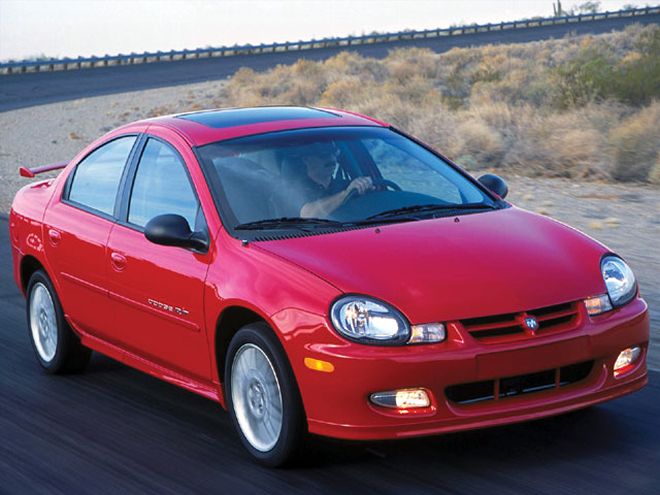

Chrysler's little Neon has developed a strong following among the sport compact car crowd, and it's not surprising. After all, the car is affordable, simply laid out, lightweight, and offers class-leading performance and handling. Chrysler certainly wasn't new to four-cylinder, front-wheel-drive performance when the first generation Neon debuted for the '95 model year. The SOHC 2-liter four-cylinder engine was essentially all new, with 132 hp at 6,000 rpm and 129 lb-ft of torque. It offered substantially more power and torque than the base engines in any competitive manufacturer's products. The DOHC engine, standard in the R/T and ACR, was rated at 150 hp at 6,500 and 133 lb-ft of torque at 5,800 rpm. With the five-speed stick, the DOHC cars were a responsive little number, turning zero-to-sixty in the mid-seven-second range.
While that's pretty good motivation for a normally aspirated four-cylinder vehicle, the performance aftermarket has been busy developing components to step it up from there. Tube Technology Incorporated (tti) in Corona, California, is a company known for their top-quality headers and exhaust system components for traditional rear-wheel-drive Mopars. With encouragement from Neon aftermarket sources, the guys at tti decided to step into the fray with a range of products for the Neon line. Development naturally centered on headers and exhaust systems, with a range of products for both the SOHC and DOHC engines. We spied the tti prototype SOHC Neon at the Mopar Nationals last year and made plans to get the lowdown on the products, and, more importantly, assess the dyno data. The test car was a '98 first-generation Neon, a stock 60,000-mile car. This test vehicle is very representative of an entry-level machine ripe for mods.
The first order of business was to get a baseline. The Neon was delivered to Brother's Performance Warehouse in Corona, California, for evaluation on their DynoJet dynamometer. In totally stock form, the Neon delivered 100.1 hp and 104.6 lb-ft of torque at the front wheels. For a stock SOHC four-cylinder, 100 hp at the wheels is a very respectable number; a showing confirmed this Neon's engine was a sound base to work from. TTI developed two styles of headers for this application: a short-tube "street" header designed to work with a catalytic converter for emissions purposes, and a "race" full-length header, which precludes the use of a cat. TTI's exhaust upgrades do not end with the header's collector flange. Along with the header, a mandrel-bent 2 1/2-inch bolt-in replacement exhaust system was designed, including a replacement high-flow catalyst. The short header system includes provisions for mounting the OE oxygen sensors both before and after the cat. With the new system in place, output was up by over 10 percent in both horsepower and torque, with wheel power moving up to 111.2 hp and 113.3 lb-ft of torque. That's a substantial gain for a late-model four-cylinder with only an exhaust system upgrade.
It's well known the stock Neon power plant suffers from a poorly designed OE air intake system. Although it represents a departure from their traditional exhaust-based product line, tti set to work developing a flow-efficient air intake system for the Neon mill. Manufactured from lightweight aluminum tubing, the tti induction pipe is mandrel bent to minimize flow-disrupting cross-sectional area changes, and features brackets and fittings to facilitate a direct bolt-in replacement for the stock equipment. The addition of the induction tube system resulted in another effective gain in power production, yielding 115 hp and 116.1 lb-ft of torque when tested in conjunction with the exhaust mods. These two bolt-on mods goosed output by a full 15 percent, an increase that is easily discernable when driving the car.
The final test configuration in this session was to replace the short header system with the full length units. The full header system is an off-road-only modification, as the collector extends to well past the location of the stock cat. The "race" header, tested with the induction ram pipe still in place, netted a small increase in peak horsepower output to 116.3 hp. More significantly effected was torque output, with the peak now edging up to 119.6 lb-ft. With the full-length header, the lower and mid-range torque filled out nicely. Compared to the stock baseline, torque at 5,000 rpm was up by 21 percent with the long header and induction tubes; power that will make itself known when you're foot is on the mat. Even the "street" system, though softer down low than the long pipes, boosted torque by about 10 percent at the bottom of our test range at 3,000 rpm, and by as much as 19 percent at 5,000 rpm. These mods will really make the Neon engine come to life.
While our dyno numbers are based upon testing the SOHC engine, tti has developed similar upgrades for the DOHC engines. Preliminary testing has shown substantial improvements are up for grabs with those engines as well.
Torque LB-FT
2-liter SOHC Neon
DynoJet Dynamometer
Tested at Brother's Performance Warehouse
Horsepower
2-liter SOHC Neon
DynoJet Dynamometer
Tested at Brother's Performance Warehouse
Legend